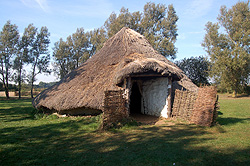Kempston in the Iron Age

A reconstruction of an Iron Age round house at Flag Fen October 2011
Finds have made it clear that there has been human activity in Kempston for a very long time. This should not be surprising given the presence of a major and navigable river as it is thought that in earliest times rivers were the major arteries of travel and communication.
The Bedfordshire Historic Environment Record [HER] contains information on the county’s historic buildings and landscapes and summaries of each entry can now be found online as part of the Heritage Gateway website. The HER records a number of Iron Age sites in Kempston.
Gravel digging in the 19th and 20th centuries revealed some Iron Age finds on the north side of Bedford Road as well as finds from the Paleaolithic, Mesolithic, Neolithic, Bronze Age, Romano-British and Anglo-Saxon periods [HER 256]. The Iron Age period seems to have seen a cemetery in the area, extending into the Romano-British period. A hearth was also identified. Items from grave sites included a handle, a loom weight and two spindle whorls.
More Iron Age activity has been discovered at the site of the modern Cutler Hammer sports ground at the corner of Cemetery Road and Kempston High Street [HER 17731]. This site has been subjected to archaeological evaluation including a geophysical survey. The results yielded ditches and pits containing small quantities of pottery. Again, this area continued in use into the Romano-British period as did an area excavated for gravel south of the river where some pottery including bowls, jars and pots were found.
Two other areas of Kempston have revealed Iron Age finds. A gold coin, known as a stater, was found south of Ford Mill [HER 15920]. It is worn but one can see the outline of a horse with a line below it. Pottery was found off Chantry Avenue [HER 14660]. This was during building works in May 1977.